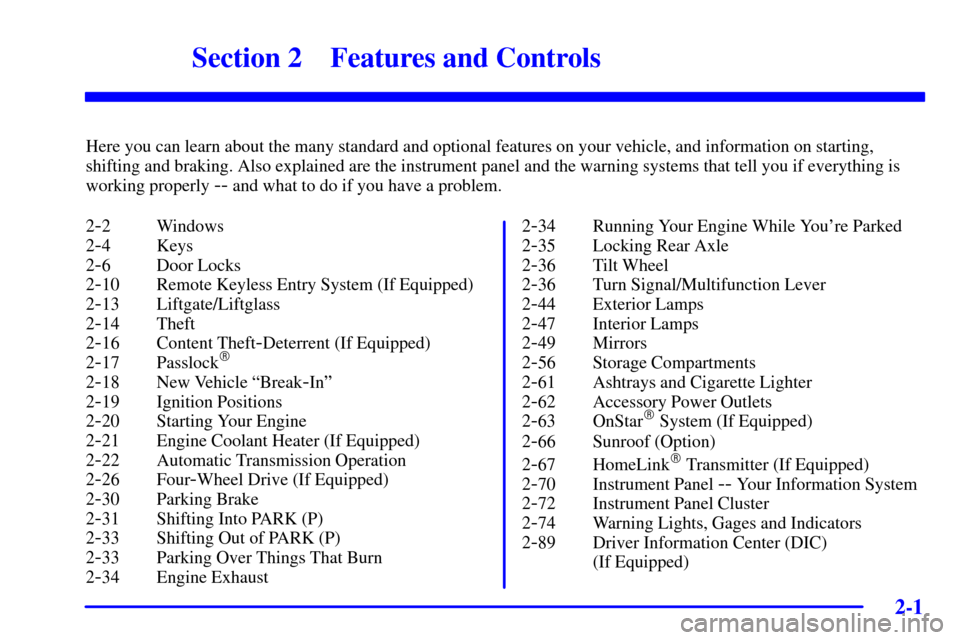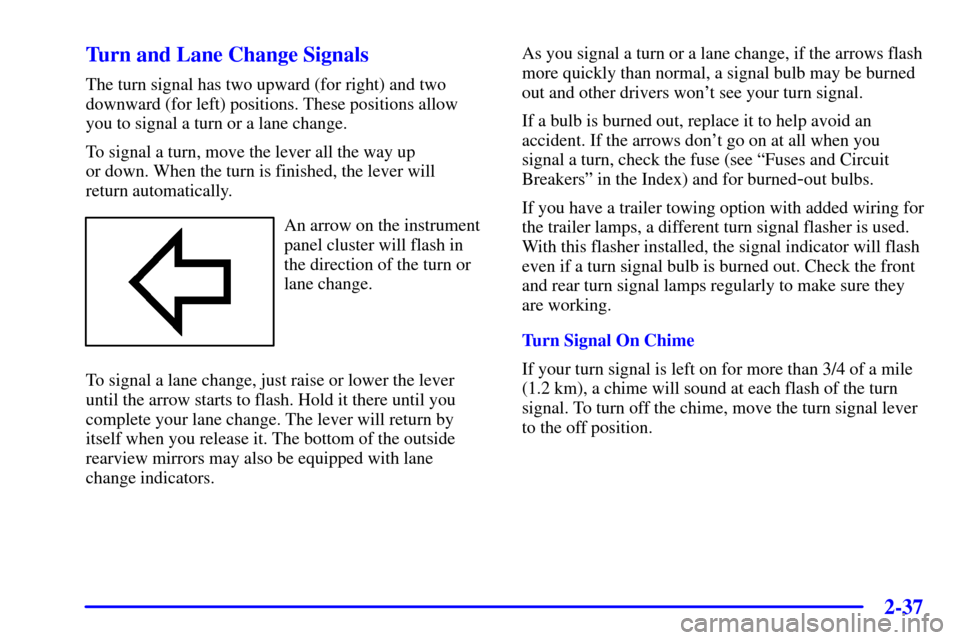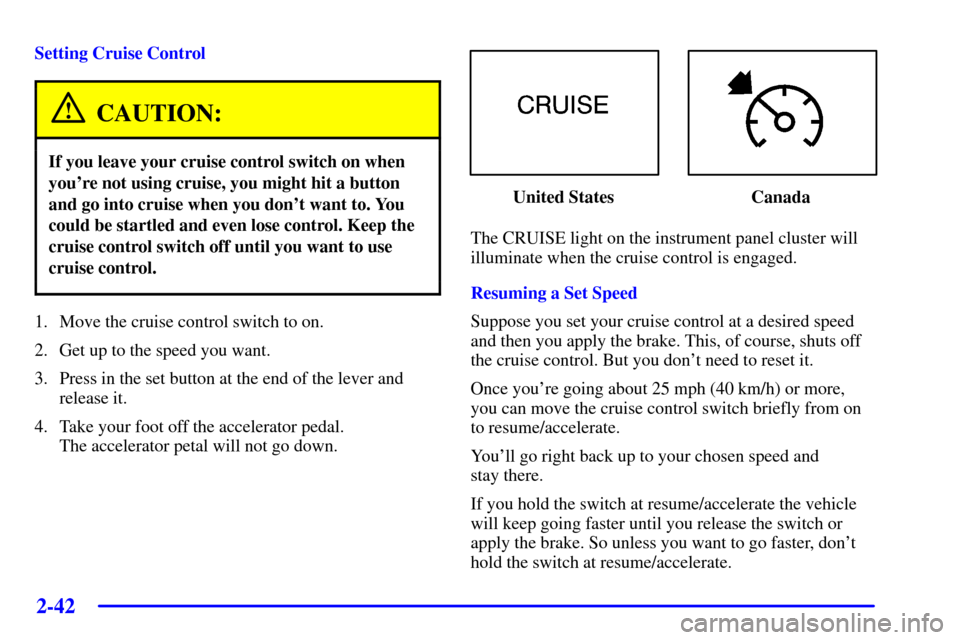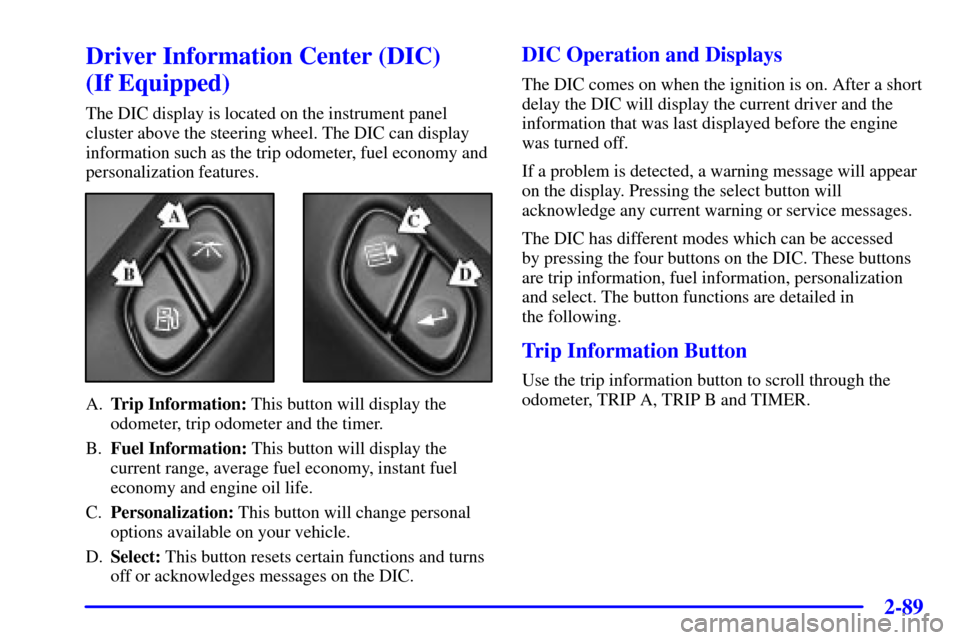Page 70 of 432

2-
2-1
Section 2 Features and Controls
Here you can learn about the many standard and optional features on your vehicle, and information on starting,
shifting and braking. Also explained are the instrument panel and the warning systems that tell you if everything is
working properly
-- and what to do if you have a problem.
2
-2 Windows
2
-4 Keys
2
-6 Door Locks
2
-10 Remote Keyless Entry System (If Equipped)
2
-13 Liftgate/Liftglass
2
-14 Theft
2
-16 Content Theft-Deterrent (If Equipped)
2
-17 Passlock�
2-18 New Vehicle ªBreak-Inº
2
-19 Ignition Positions
2
-20 Starting Your Engine
2
-21 Engine Coolant Heater (If Equipped)
2
-22 Automatic Transmission Operation
2
-26 Four-Wheel Drive (If Equipped)
2
-30 Parking Brake
2
-31 Shifting Into PARK (P)
2
-33 Shifting Out of PARK (P)
2
-33 Parking Over Things That Burn
2
-34 Engine Exhaust2
-34 Running Your Engine While You're Parked
2
-35 Locking Rear Axle
2
-36 Tilt Wheel
2
-36 Turn Signal/Multifunction Lever
2
-44 Exterior Lamps
2
-47 Interior Lamps
2
-49 Mirrors
2
-56 Storage Compartments
2
-61 Ashtrays and Cigarette Lighter
2
-62 Accessory Power Outlets
2
-63 OnStar� System (If Equipped)
2
-66 Sunroof (Option)
2
-67 HomeLink� Transmitter (If Equipped)
2
-70 Instrument Panel -- Your Information System
2
-72 Instrument Panel Cluster
2
-74 Warning Lights, Gages and Indicators
2
-89 Driver Information Center (DIC)
(If Equipped)
Page 97 of 432

2-28
If the SERVICE 4WD light on the instrument panel
cluster stays on, you should take your vehicle to your
dealer for service. See ªService 4WDº in the Index for
further information.
Shifting to 4HI or A4WD
Turn the knob to 4HI or A4WD. This can be done at any
speed and the indicator light will flash while shifting. It
will remain illuminated when the shift is complete.
Shifting to 2HI
Turn the knob to 2HI. This can be done at any speed.
Shifting to 4LO
To shift to 4LO, the vehicle's engine must be running
and the vehicle must be stopped or moving less than
2 mph (3.2 km/h) with the transmission in
NEUTRAL (N). The preferred method for shifting into
4LO is to have your vehicle moving 1 or 2 mph
(1.6 to 3.2 km/h). Turn the knob to 4LO. You must wait
for the 4LO indicator light to stop flashing and remain
illuminated before shifting your transmission into gear.If you knob to 4LO when your vehicle is in gear
and/or moving, the 4LO indicator light will flash for
30 seconds and not complete the shift unless your
vehicle is moving less than 2 mph (3.2 km/h) and the
transmission is in NEUTRAL (N). After 30 seconds, the
transfer case will return to the setting last chosen.
Shifting Out of 4LO
To shift from 4LO to 4HI, A4WD or 2HI your vehicle
must be stopped or moving less than 2 mph (3.2 km/h)
with the transmission in NEUTRAL (N) and the engine
running. The preferred method for shifting out
of 4LO is to have your vehicle moving 1 or 2 mph
(1.6 to 3.2 km/h). Turn the knob to 4HI, A4WD or 2HI.
You must wait for the 4HI, A4WD or 2HI indicator light
to stop flashing and remain illuminated before shifting
your transmission into gear.
If the 4HI, A4WD or 2HI knob is turned when your
vehicle is in gear and/or moving, the 4HI, A4WD
or 2HI indicator light will flash for 30 seconds but
will not complete the shift unless your vehicle is
moving less than 2 mph (3.2 km/h) with the
transmission in NEUTRAL (N).
Page 106 of 432

2-37
Turn and Lane Change Signals
The turn signal has two upward (for right) and two
downward (for left) positions. These positions allow
you to signal a turn or a lane change.
To signal a turn, move the lever all the way up
or down. When the turn is finished, the lever will
return automatically.
An arrow on the instrument
panel cluster will flash in
the direction of the turn or
lane change.
To signal a lane change, just raise or lower the lever
until the arrow starts to flash. Hold it there until you
complete your lane change. The lever will return by
itself when you release it. The bottom of the outside
rearview mirrors may also be equipped with lane
change indicators.As you signal a turn or a lane change, if the arrows flash
more quickly than normal, a signal bulb may be burned
out and other drivers won't see your turn signal.
If a bulb is burned out, replace it to help avoid an
accident. If the arrows don't go on at all when you
signal a turn, check the fuse (see ªFuses and Circuit
Breakersº in the Index) and for burned
-out bulbs.
If you have a trailer towing option with added wiring for
the trailer lamps, a different turn signal flasher is used.
With this flasher installed, the signal indicator will flash
even if a turn signal bulb is burned out. Check the front
and rear turn signal lamps regularly to make sure they
are working.
Turn Signal On Chime
If your turn signal is left on for more than 3/4 of a mile
(1.2 km), a chime will sound at each flash of the turn
signal. To turn off the chime, move the turn signal lever
to the off position.
Page 107 of 432
2-38
Headlamp High/Low-Beam Changer
To change the headlamps from low to high beam, push
the lever toward the instrument panel. To return to
low
-beam headlamps, pull the multifunction lever
toward you. Then release it.
When the high beams are
on, this indicator light on
the instrument panel cluster
will also be on.
Flash-to-Pass Feature
This feature lets you use your high-beam headlamps
to signal a driver in front of you that you want to pass.
It works even if your headlamps are in the
automatic position.
To use it, pull the turn signal lever toward you, then
release it.
If your headlamps are in the automatic position or on
low beam, your high
-beam headlamps will turn on.
They'll stay on as long as you hold the lever toward
you. The high
-beam indicator on the instrument panel
cluster will come on. Release the lever to return to
normal operation.
Page 111 of 432

2-42
Setting Cruise Control
CAUTION:
If you leave your cruise control switch on when
you're not using cruise, you might hit a button
and go into cruise when you don't want to. You
could be startled and even lose control. Keep the
cruise control switch off until you want to use
cruise control.
1. Move the cruise control switch to on.
2. Get up to the speed you want.
3. Press in the set button at the end of the lever and
release it.
4. Take your foot off the accelerator pedal.
The accelerator petal will not go down.
United States Canada
The CRUISE light on the instrument panel cluster will
illuminate when the cruise control is engaged.
Resuming a Set Speed
Suppose you set your cruise control at a desired speed
and then you apply the brake. This, of course, shuts off
the cruise control. But you don't need to reset it.
Once you're going about 25 mph (40 km/h) or more,
you can move the cruise control switch briefly from on
to resume/accelerate.
You'll go right back up to your chosen speed and
stay there.
If you hold the switch at resume/accelerate the vehicle
will keep going faster until you release the switch or
apply the brake. So unless you want to go faster, don't
hold the switch at resume/accelerate.
Page 140 of 432
2-71
The main components of your instrument panel are the following:
A. Exterior Lamp Controls
B. Air Vents
C. Turn Signal/Multifunction Lever
D. Instrument Panel Cluster
E. Ignition Switch
F. Transfer Case Controls (If Equipped) or
Traction Control Button (If Equipped)
G. Rear Window Washer/Wiper
H. Audio SystemI. Comfort Controls
J. Hood Release
K. Ashtray
L. Shift Lever
M. Lighter
N. Accessory Power Outlet
O. Rear Window Defogger
P. Glove Box
Page 141 of 432
2-72
Instrument Panel Cluster
Your instrument panel cluster is designed to let you know at a glance how your vehicle is running. You'll know
how fast you're going, about how much fuel you've used, and many other things you'll need to know to drive safely
and economically.
United States version shown, Canada similar
Page 158 of 432

2-89
Driver Information Center (DIC)
(If Equipped)
The DIC display is located on the instrument panel
cluster above the steering wheel. The DIC can display
information such as the trip odometer, fuel economy and
personalization features.
A.Trip Information: This button will display the
odometer, trip odometer and the timer.
B.Fuel Information: This button will display the
current range, average fuel economy, instant fuel
economy and engine oil life.
C.Personalization: This button will change personal
options available on your vehicle.
D.Select: This button resets certain functions and turns
off or acknowledges messages on the DIC.
DIC Operation and Displays
The DIC comes on when the ignition is on. After a short
delay the DIC will display the current driver and the
information that was last displayed before the engine
was turned off.
If a problem is detected, a warning message will appear
on the display. Pressing the select button will
acknowledge any current warning or service messages.
The DIC has different modes which can be accessed
by pressing the four buttons on the DIC. These buttons
are trip information, fuel information, personalization
and select. The button functions are detailed in
the following.
Trip Information Button
Use the trip information button to scroll through the
odometer, TRIP A, TRIP B and TIMER.